Competition File (Multiple choice question) based on a given passage/comprehension from MODERN PUBLISHERS PHYSICS Chapter 25 OSCILLATIONS for Class 11
| Class 11 | PHYSICS |
| Chapter | OSCILLATIONS |
| MODERN PUBLISHERS PHYSICS | Competition File (Multiple choice question) based on a given passage/comprehension |
| Medium | English |
| Academic Year | 2023-2024 |
Question 1
A uniform cylinder of mass m, length l and cross sectional area A is suspended with its vertical from a fixed point, with the help of a massless spirng of force constant (K), The cylinder is then submerged in a liquid of density p. At equilibrium the cylinder remains submerged in the liquid with 1/4th of its volume outside the liquid, as shown in the figure. The elongation of hte spring at this point is x0. WHen the cylinder is given a slight downward push into the liquid and then released, its starts oscillating with vertical S.H.M. of small amplitude.
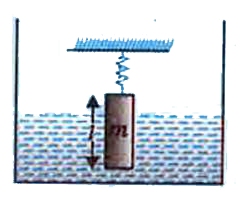
The elongation X0 produced in the springs when the syste is in equilibrium is View SolutionQuestion 2
A uniform cylinder of mass m, length l and cross sectional area A is suspended with its vertical from a fixed point, with the help of a massless spirng of force constant (K), The cylinder is then submerged in a liquid of density p. At equilibrium the cylinder remains submerged in the liquid with 1/4th of its volume outside the liquid, as shown in the figure. The elongation of hte spring at this point is x0. WHen the cylinder is given a slight downward push into the liquid and then released, its starts oscillating with vertical S.H.M. of small amplitude.
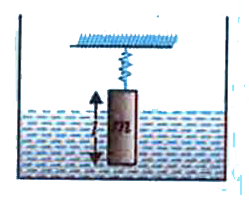
If the cyleinder is displced by a small downward displacement a from its equilibrium postion and then released , the restoring force on it will be View SolutionQuestion 3
A uniform cylinder of mass m, length l and cross sectional area A is suspended with its vertical from a fixed point, with the help of a massless spirng of force constant (K), The cylinder is then submerged in a liquid of density p. At equilibrium the cylinder remains submerged in the liquid with 1/4th of its volume outside the liquid, as shown in the figure. The elongation of hte spring at this point is x0. WHen the cylinder is given a slight downward push into the liquid and then released, its starts oscillating with vertical S.H.M. of small amplitude.
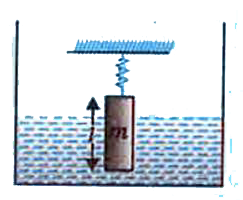
Time period of vertical S.H.M of the cylinder is View SolutionQuestion 4
A light spring of force constant k is attached to a block of mass M placed on a horizontal firctionless surface from its one end and other end is fixed to a right support. The system is executing S.H.M. of amplitude A1 and time period T1. At some instant, the block passed through the equilibrium position and a small object of mass m is placed on it. The new amplitude and time period of the system now becomes A2 and T2 respectively.
The ratio T2T1 is View SolutionQuestion 5
A light spring of force constant k is attached to a block of mass M placed on a horizontal firctionless surface from its one end and other end is fixed to a right support. The system is executing S.H.M. of amplitude A1 and time period T1. At some instant, the block passed through the equilibrium position and a small object of mass m is placed on it. The new amplitude and time period of the system now becomes A2 and T2 respectively.
The velcities of block before and after the object is placed on it are V1 and V2 respectively. Then the ratio V2/V1View SolutionQuestion 6
A light spring of force constant k is attached to a block of mass M placed on a horizontal firctionless surface from its one end and other end is fixed to a right support. The system is executing S.H.M. of amplitude A1 and time period T1. At some instant, the block passed through the equilibrium position and a small object of mass m is placed on it. The new amplitude and time period of the system now becomes A2 and T2 respectively.
The ratio A2/A1 is View SolutionQuestion 7
When a particle is mass m moves on the x− axis in a potential of the from V(x)=kx2, it performs simple harmonic motion. The corresponding thime periond is proportional to √mk, as can be seen easily asing dimensional analysis. However, the motion of a pariticle can be periodic even when its potential enem increases on both sides x=0 in a way different from kx2 and its total energy is such that the particel does not escape to infinity. consider a particle of mass m moving onthe x−axis . Its potential energy is V(x)=ω(α>0) for |x| near the origin and becomes a constant equal to V0 for |x|≥X0 (see figure)
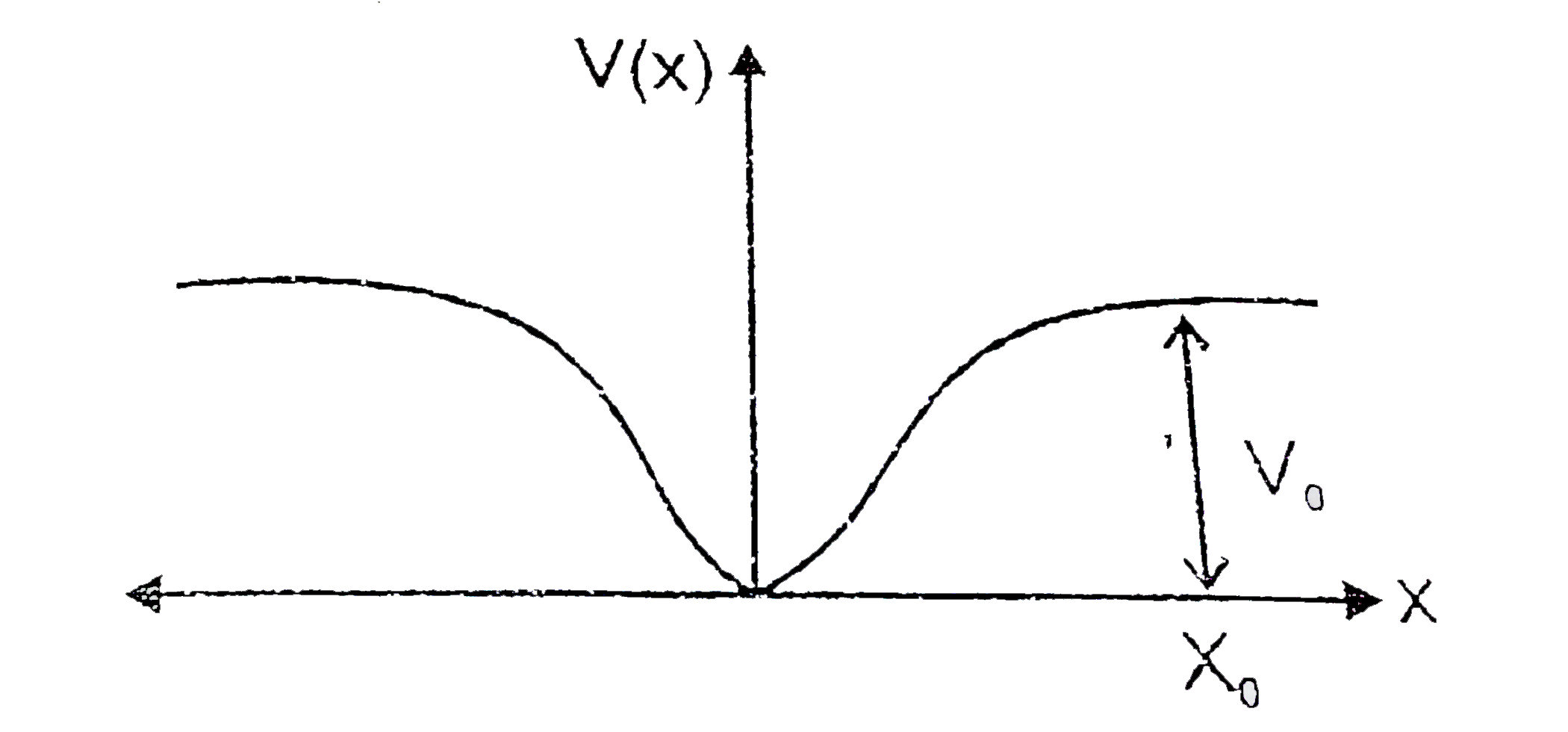
If the total energy of the particle is E, it will perform is periodic motion why if :View SolutionQuestion 8
When a particle of mass m moves on the X-axis in a potential of the form V(x)=kx2, it performs simple harmonic motion. The corresponding time period is proportional to
√mk, as can be seen easily using dimensional analysis.
However, the motion of a particle can be periodic even when its potential energy increases on both sides of x = 0 in a way different from kx2 and its total energy is such that the particle does not escape to infinity. Consider a particle of mass m moving on the X-axis. Its potential energy is V(x) =ax2(a>0) for |x| near the origin and becomes a constant equal to V0 for |x|≥X0

For periodic motion os small amplitude A . The time periodic T of this particle is proportional to View SolutionQuestion 9
When a particle of mass m moves on the X-axis in a potential of the form V(x)=kx2, it performs simple harmonic motion. The corresponding time period is proportional to
√mk, as can be seen easily using dimensional analysis.
However, the motion of a particle can be periodic even when its potential energy increases on both sides of x = 0 in a way different from kx2 and its total energy is such that the particle does not escape to infinity. Consider a particle of mass m moving on the X-axis. Its potential energy is V(x) =ax2(a>0) for |x| near the origin and becomes a constant equal to V0 for |x|≥X0
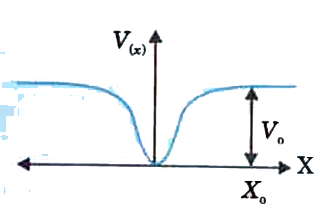
The acceleration of this particle for |X|>X0 is View Solution
All Exercises from MODERN PUBLISHERS PHYSICS Class 11 PHYSICS OSCILLATIONS
- Competition ASSERTION REASON TYPE QUESTIONS
- Competition (INTEGER TYPE QUESTIONS)
- Competition File (JEE (Advanced) For IIT Entrance)
- Competition File (MATRIX MATCH TYPE QUESTIONS)
- Competition File (Matching Type Questions)
- Competition File (Multiple choice question)
- Competition File (Multiple choice question) based on a given passage/comprehension
- Competition File (Multiple choice questions)
- Competition File (Multiple choice questions) AIPMT/NEET other State Boards for Medical Entrance
- Competition file (Multiple choice question) JEE (Main) & Other State Boards for Engineering Entrance
- Conceptual Questions
- HOTS (Higher Order Thinking Skills & Advanced Level)
- NCERT (Additional Exercises)
- NCERT Exemplar Problems Subjective Question ( short Answer Type Questions )
- NCERT Exemplar Problems Subjective Question (Multiple Choice Questions (Type-I))
- NCERT Exemplar Problems Subjective Question (Multiple Choice Questions (Type-II))
- NCERT Exemplar Problems Subjective Question (Very short Answer Type Questions )
- NCERT FILE (Textbook Exercises)
- PRACTICE PROBLEMS
- PRACTICE PROBLEMS 2
- Practice Test (For Board Examination)
- Revision Exercises (Additional Question )
- Revision Exercises (Long Answer Questions)
- Revision Exercises (Numerical Problems)
- Revision Exercises (Short Answer Questions)
- Revision Exercises (Very Short Answer Questions)
- Revision Exercises (fill in the blanks)
- SOLVED EXAMPLES
- TOUGH & TRICKY PROBLEMS
